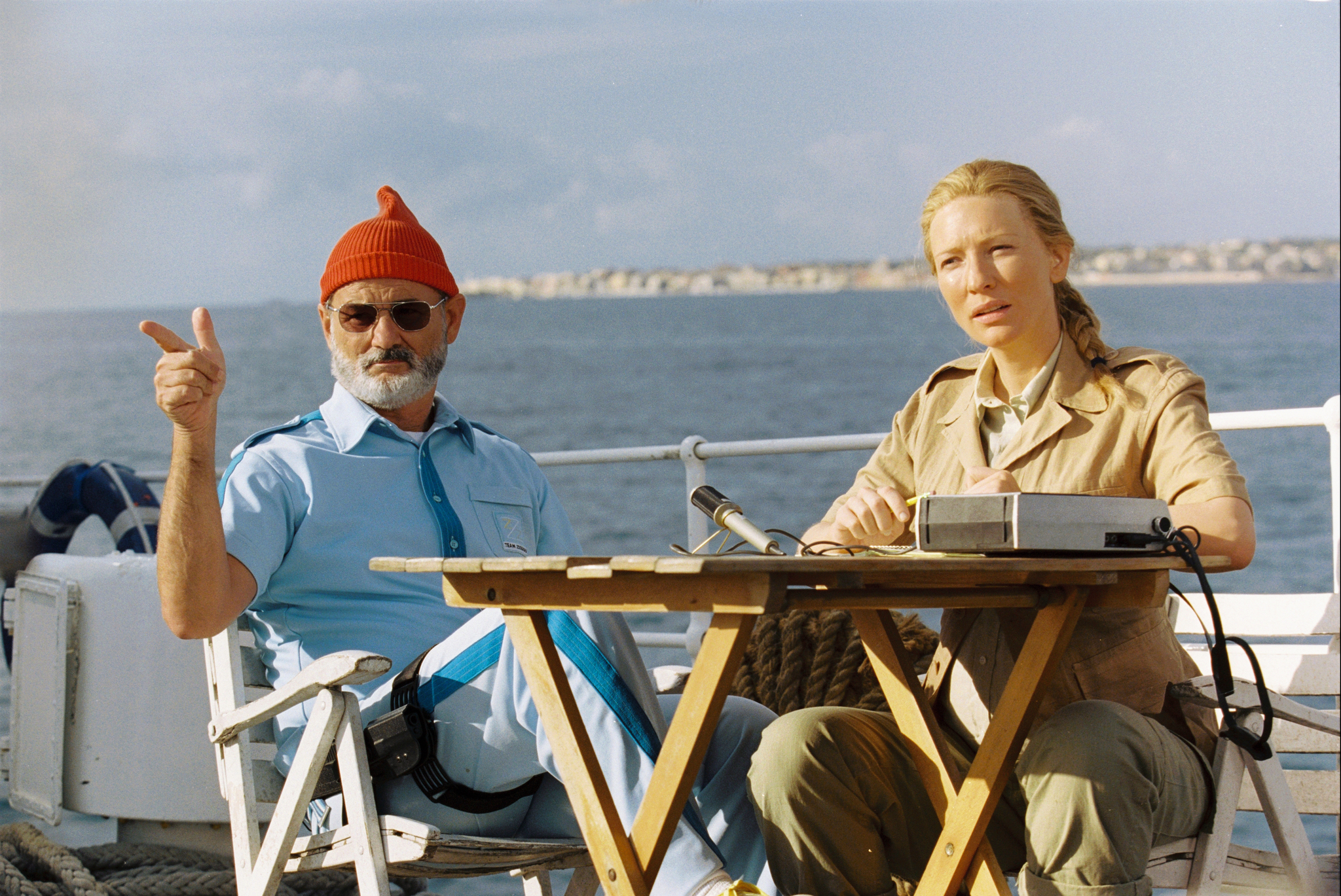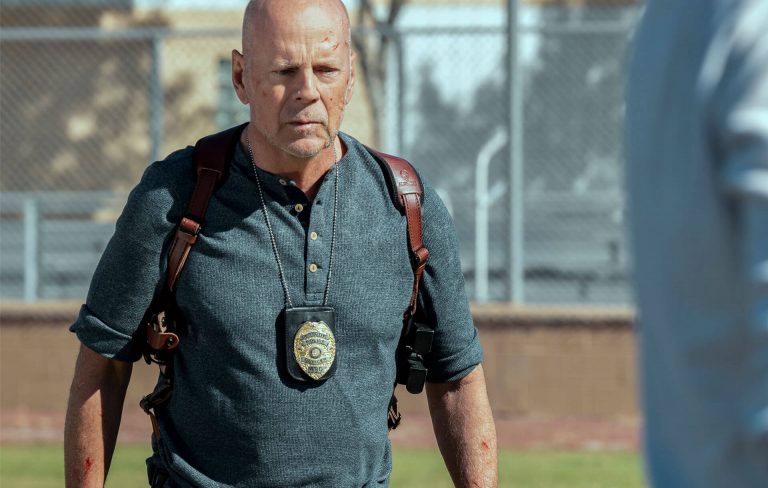The Life Aquatic with Steve Zissou (2004) Movie Review: Made after ‘Royal Tenenbaums” (2001) – one of the benchmark works in Wes Anderson’s filmography – “The Life Aquatic” (2004) fell under the weight of crushing expectations as many such follow-ups do. Spike Lee once said that filmmakers like Elia Kazan and Billy Wilder often do their best work when they follow up their big commercial hits like Ace in the Hole and Face in the Crowd because they’re allowed to experiment. Anderson simply used a bigger budget to deliver something stylistically different from its predecessor. It was a recipe for high expectations upon its 2004 release, but the film deserves a re-evaluation when watched later in time.
Anderson created the film as a homage to the wondrous undersea world of oceanographer Jacques Cousteau. His title character Steve Zissou (played by Anderson regular Bill Murray), is a deep sea explorer who creates the kind of films that anyone who shares a Cousteau fan’s love of the sea would enjoy, particularly with Anderson’s undeniable gift for visuals. If Wes Anderson is guilty of self-indulgence, the “The Let Me Tell You About My Boat” sequence is a welcome dose of vanity.
At the same time, the film is centered around a jaded character on a downhill slide. Steve Zissou is what would happen if Jacques Cousteau caught a few bad breaks later in life. To the degree that good character development is revealed through the unpeeling of layers, Steve Zissou appears to be more and more of an empty construct as we learn more about him. It’s revealed that he’s more of a showman than a scientist. Additionally, the presence of journalist Jane Winslett-Richardson (Cate Blanchett) on his expedition means that he must always be in front of her.
It’s perhaps the pressure of tighter funding or the fact that he was always ugly, to begin with, that Zissou becomes more and more defeated as he realizes he can’t control his narrative. It’s probably not accidental that the cultured Zissou can’t seem to connect the dots between his quest to hunt down the shark that killed his best friend and the doomed Captain Ahab. The brains behind his operation, estranged wife Eleanor (Anjelica Huston), advises against the mission. This can’t be a good sign.
There’s also the blaring juxtaposition that killing any animal is pretty much the antithesis of any scientific expedition. At a certain point, one wonders if the “scientific lab” that Zissou advertises in his “Let Me Tell You About My Boat” sequence has any application beyond the aesthetic. Zissou, after all, admits at one point that no one in his crew is an oceanographer.

Wes Anderson has a unique style, but what’s overlooked is how well the detailed craftwork serves the story. The typography is not only memorable and period-appropriate, but it blurs that reality because it opens both the movie and the documentary-within-the-film. The soundtrack is another example of this brilliance. Portuguese covers of David Bowie songs are diegetically worked into the soundtrack through Seu Jorge playing a crew member. In more reality-shaking moments, the death of Steve’s probable long-lost son or Steve nearing on his imaginary shark quest, non-diegetic songs like “Search and Destroy” (Iggy and the Stooges), “The Way I Feel Inside” (The Zombies), or even the original David Bowie version of “Life on Mars” overtake the soundscape.
The Life Aquatic’s most significant flaw might be its bloated cast. Acting titans like Bud Cort, Jeff Goldblum, and Michael Gambon are stuck in minor, thankless roles that could have gone to character actors. With his accent and childlike sense of neediness, Willem Dafoe’s sidekick character can best be described as wacky. Distinguished actors like Gene Hackman and Danny Glover lent themselves to lighter character roles for “The Royal Tenenbaums.” Still, it feels like Dafoe crosses too far over a line of hamminess for this to be a dignified addition to his filmography.
At the same time, the cast size seems retrospectively quaint compared to the unchecked gargantuan of late-stage Anderson. If someone didn’t enjoy Life Aquatic for its bloat, it would be hard for them not to reconsider when “The French Dispatch” (or even a consensus masterpiece like “Grand Budapest Hotel”) boasted superfluous star cameos in over half the roles.
The most significant moment in “The Life Aquatic with Steve Zissou” is a simple hug between two rivals. The scene occurs towards the movie’s end: The title character Steve Zissou (Bill Murray), expresses a defeated sigh to his opponent, Allistair Hennesy (Goldblum). “We’ve never made great husbands, have we?” Zissou says about his estranged wife, to whom Hennessy was also married. “Of course, I have a good excuse. I’m part gay,” responds Hennesy as the two exchange an embrace out of nowhere.
This is the essence of what Wes Anderson is about. His stories are about one emotion- the common human need to belong – that trumps all the others. In the same way, Wes Anderson’s glamorous visual facades withhold a more complex emotional state. Wayward emotions like jealousy, respect, self-actualization, and navigating drifting love are framing devices that drive the story. Steve Zissou, and most Wes Anderson protagonists, are really after a universal human connection. Even if it means from a rival. The story can never become too dour when the protagonist is never more than a hug away from being saved from misery. Wes Anderson’s films have an overarching theme of human connection, and “The Life Aquatic with Steve Zissou” is no exception.







![Everything Is Cinema [2021] Review: An Inspiringly Fleshed-Out Docufiction That Hits Strangely Affecting Notes](https://79468c92.delivery.rocketcdn.me/wp-content/uploads/2021/08/Everthing-is-Cinema-768x479.jpg)